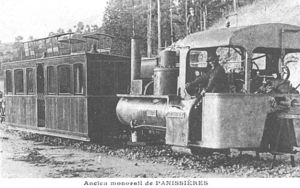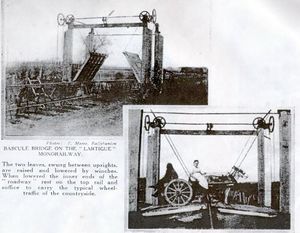Lartigue Monorail
The Lartigue Monorail system was invented by the French engineer Charles Lartigue (1834-1907). The most famous Lartigue railway was the Listowel and Ballybunion Railway.
Lartigue had seen camels in Algeria carrying heavy loads balanced in panniers on their backs. This inspired him to design a new type of railway. Instead of two parallel tracks on the ground, it had a single rail sitting above the sand and held at waist height on A-shaped trestles. The carriages would sit astride the trestles like panniers.
By 1881 Lartigue had built a 90km monorail to transport esparto grass across the Algerian desert, with mules pulling trains of panniers that straddled the elevated rail.
The Listowel and Ballybunion Railway
This was a 9 mile monorail built on the Lartigue principle in County Kerry in Ireland. It opened on 1 March 1888.
The locomotives were of the 0-6-0 type (strictly speaking, '0-3-0'), constructed by the Hunslet Engine Company. They were specially built with two boilers in order to balance on the track. Loads also had to be evenly balanced. If a farmer wanted to send a cow to market, he would have to send two calves to balance it, which would travel back on opposite sides of the same freight wagon, thereby balancing each other.
Another problem with using the Lartigue system in populated areas was that, due to the track's design, it was not possible to build level crossings. In order for a road to cross the track, a kind of double-sided drawbridge had to be constructed, which required an attendant to operate it.
The line closed in 1924 after the track was damaged during the Irish Civil War, and everything was scrapped except a short section of the track.
In 2003 the Lartigue Monorailway Restoration Committee, a voluntary organisation from Listowel, opened a 500 metre section of Lartigue monorail on the trackbed of the former North Kerry line, including a replica locomotive and coaches closely resembling the original design, built by Alan Keef Ltd.
Another example
Another inventor in the 1970s built a forestry railway system using A-frame rails laid directly on the ground[citation needed]. The locomotive incorporated a crane which could move the track panels around as required. Since the line only carry one product, it is relatively easy, as with the grass hauled by the Algerian mule-railway, to balance the loads.
Reference
- Newham, A.T., (1989) The Listowel & Ballybunion Railway, Oakwood Press, No. LP33, ISBN 0 85361 093 2
External links
- The Rebuilt Lartigue Monorailway website
- Lartigue railway photos (2004)
- The Lartigue System at The Museum of Retrotech


